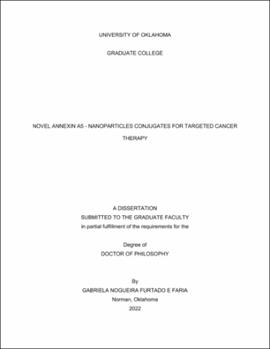| dc.contributor.advisor | Harrison, Roger | |
| dc.contributor.author | Nogueira Furtado e Faria, Gabriela | |
| dc.date.accessioned | 2022-12-09T22:57:46Z | |
| dc.date.available | 2022-12-09T22:57:46Z | |
| dc.date.issued | 2022-12-09 | |
| dc.identifier.uri | https://hdl.handle.net/11244/336914 | |
| dc.description.abstract | Cancer is considered the single most critical barrier to improving life expectancy in every country. More specifically, the high prevalence of breast cancer is a global health concern, but there are no safe or effective treatments for it at its advanced stages. Those facts urge the development of novel treatment strategies.
Annexin A5 (ANXA5) is a natural human protein that binds with high specificity to phosphatidylserine, a phospholipid tightly maintained in the inner leaflet of the cell membrane on most healthy cells but externalized in tumor cells, tumor vasculature, and metastatic cells. We have linked annexin A5 to single-walled carbon nanotubes (SWCNT) and gold nanoparticles (AuNP) in this work.
First, we have developed a targeted photosensitizer for photothermal therapy (PTT) of solid tumors through the functionalization of SWCNT to ANXA5: the SWCNT-ANXA5 conjugate. The ablation of tumors through the SWCNT-ANXA5-mediated PTT synergizes with checkpoint inhibition creating a systemic anti-cancer immune response. This treatment strategy was tested in two murine breast cancer tumor models, EMT6 and 4T1. Although EMT6 tumors are aggressive and metastatic, 4T1 tumors are considered even more threatening and less immunogenic than EMT6. For both tumors, enhanced therapeutic effects were achieved. While EMT6 tumors were treated with lower temperatures in the PTT, 4T1 required higher temperatures and the addition of an immune adjuvant to induce curative effects. For both studies, evidence of immune system activation strengthens the hypothesis of an abscopal effect. SWCNT-ANXA5 was also studied as a responsive material for radiofrequency ablation (RFA), showing an impressive heating rate and potential for carbon nanotube-mediated RFA of tumors.
Lastly, a multi-modal conjugate for the detection and therapy of cancer was developed linking ANXA5 to a chemotherapeutic drug, mertansine (DM1), and gold nanoparticles (AuNP) for drug delivery and contrasting agent in microCT scans in the diagnosis of breast cancer. Those linkages created the conjugate AuNP-ANXA5-DM1. This novel agent was able to induce cytotoxic effects and has the potential to increase the effectiveness of chemotherapeutic delivery to solid tumors. | en_US |
| dc.language | en | en_US |
| dc.subject | Breast Cancer Therapy | en_US |
| dc.subject | Photothermal Therapy | en_US |
| dc.subject | Nanoparticles Bioconjugates | en_US |
| dc.subject | Immune Checkpoint Inhibition | en_US |
| dc.title | Novel annexin A5 - nanoparticles conjugates for targeted cancer therapy | en_US |
| dc.contributor.committeeMember | Sikavitsas, Vassilios | |
| dc.contributor.committeeMember | Resasco, Daniel | |
| dc.contributor.committeeMember | Papavassiliou, Dimitrios | |
| dc.contributor.committeeMember | McNally, Lacey | |
| dc.contributor.committeeMember | Razaq, Wajeeha | |
| dc.date.manuscript | 2022-12-09 | |
| dc.thesis.degree | Ph.D. | en_US |
| ou.group | Gallogly College of Engineering::School of Chemical, Biological and Materials Engineering | en_US |
| shareok.orcid | 0000-0001-6470-9623 | en_US |
